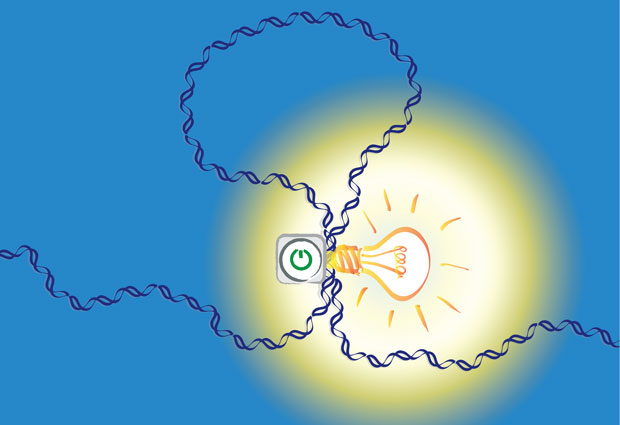Life in 3D
Scientists at EMBL Heidelberg and Stanford University in the USA, have shed new light on how the variations in our molecular make-up, such as gene expression, are controlled within our DNA.

The research, published today in Cell, leads to a greater understanding of how certain genetic variants can ‘switch’ on or off the regulatory elements which control the expression of genes and ultimately the manifestation of an individual’s characteristics and disease predispositions.
These variants are found in regions of the genome which are not directly responsible for coding genes, but which instead have a regulatory function. Not much is yet known about these regions, however, research into how the variants work could eventually lead to new clues about how human diseases might be understood at a genetic level and, ultimately, controlled.
“We know many genetic variants are associated with different diseases, but since most of them lie in the non-coding part of the genome, we often don’t know what the precise mechanisms underlying these associations are,” explains Judith Zaugg, who led the study at EMBL. “Our results, and the computational approaches we have developed mean it will now be possible to take these variants and link them back to the regulatory network within the DNA to identify the specific gene that is associated with them. This might enable us to unravel the causal mechanisms behind certain inherited diseases.”
‘Switches’ controlling gene expression might be far apart on DNA strand, but close in 3D space.
Key to the process are regions in the non-coding part of the DNA that harbour specific sequences, called enhancers and promoters. These are responsible for activating the expression of a particular gene. Promoters are located close to the gene they regulate. Enhancers, in contrast, can be far away from their target gene in terms of genomic location and might require physical interaction with the promoter of a gene to propagate the activity signal. One of the big challenges in understanding how genes are controlled is to link these enhancers to their target genes.
In this study, the team has generated molecular profiles from 75 human individuals that were sequenced as part of the 1000 Genomes Project – an international collaboration to produce an extensive catalogue of human genetic variation.
They used epigenetic marks to identify enhancers and promoters within the subjects’ genome and, using a second technology (Hi-C) were able to map how enhancers and promoters were interacting in three-dimensional space. As well as charting the specific interactions between promoters and enhancers using genotype information, the team were able to find genetic associations between physically interacting regions of the genome, thus providing evidence for functional interactions between enhancers and promoters.
Map of genetic ‘switches’ will pave the way for understanding the molecular basis of complex genetic diseases.
An unexpected finding was that often it was not only genetic variants in enhancers that were associated with gene expression, but also regulatory elements in promoters of a distal genes that were physically and genetically connected to the gene of interest.
Genes are known to physically interact with multiple enhancers. In addition, the team also discovered that some promoters are genetically controlled by two or more enhancers, meaning that the enhancers either work in combination to affect gene expression or compensate each other. For example, if one individual lacks a particular enhancer there might be a backup enhancer that could compensate for the loss. Such a compensation mechanism could explain why it is so difficult to identify the causal variants of complex genetic diseases.
“The approach we used enables us to map links between genes and their regulatory elements,” says Fabian Grubert, who led the work at Stanford University, in Michael Snyder’s lab. “Further studies in different tissues will add even more detail to the map, and hopefully will allow us to identify all the enhancers and promoters that influence a single gene under different conditions.”



